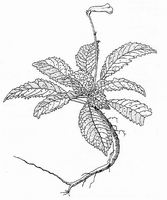
Beitr. Biol. Pflanzen 70: 241, fig. 3 (1998), drawing by D. Hadl
Full name and orig. publication: Ridleyandra A.Weber & B.L.Burtt, Beitr. Biol. Pflanzen 70 (2-3): 171 (26 Nov. 1998, "1997").
Etymology: The first part of the name honors Henry Nicholas Ridley (1855-1956), an eminent English botanist working in Singapore, the Malay Peninsula and surrounding areas. The ending –andra (from the Greek ανδρος, andros = male, alluding to the androecium) echoes the plants’ previous position in Didissandra.
Synonyms: Didissandra sect. Stilpnothrix C.B.Clarke (1883). Didissandra sect. Speciosae Ridl. (1905).
Infrafamilial position: Didymocarpoid Gesneriaceae - "Advanced Asiatic and Malesian genera" (Weber 2004).
Description: Perennial lignescent herbs. Stem woody (except R. tenella), short or elongate, ± erect, often hairy. Leaves usually in a dense rosette or loose tuft on top of the stem; petiolate, lamina obovate, elliptical or lanceolate; margin entire, dentate, serrate, deeply saw-toothed or wavy; often glabrous on upper side, but (sometimes) with minute sessile 2-celled glands. Cymes axillary; peduncle elongate, bracteoles broad-lanceolate to linear; with one or several flowers. Sepals free to base. Corolla long- and rather broad-tubed to very short-tubed with nearly flat limb, limb bilabiate, lobes rounded. Stamens 4, didynamous, filaments long or (in the short-tubed species) short; anthers cohering in pairs at the apex, occasionally all four coherent, sometimes with spur-like outgrowths. Nectary cup-shaped or a low ring or lacking. Ovary ovoid to elongate, usually glabrous; stigma (always?) formed by the lower carpel. Fruit capsular, elongate or short, wall thick, ± fleshy or dry, dehiscing on the upper side only. Seeds numerous, small, elliptical, testa cells with a longitudinal ridge in the middle (except R. tenella).
Chromosome number: 2n = 34.
Species number: Over 20.
Type species: Ridleyandra atrocyanea (Ridl.) A.Weber & B.L.Burtt
Species names (incl. publication and synonyms): See Skog, L.E. & J.K. Boggan. 2005: World checklist of Gesneriaceae: http://persoon.si.edu/Gesneriaceae/Checklist.
Distribution: Malay Peninsula and Borneo.
Ecology: In lowland and (more frequently) montane rain forests.
Notes: The genus is one of the segregates of Didissandra C.B.Clarke (see Weber & Burtt 1998a). It can be divided into two morpho-geographical groups:
(a) sect. Ridleyandra (approx. 18 spp., corolla with long tube, nectary present; Malay Peninsula, and
(b) sect. Stilpnothrix (C.B.Clarke) A.Weber & B.L.Burtt (5 spp., Borneo; corolla short-tubed to flat-faced, nectary lacking).
The Bornean species show a gradual acquisition of the pollination syndrome of oligandric pollen flowers. Evidence that the two groups are congeneric is provided by the characteristic seed coat structure (testa cells with longitudinal ridge in the middle) (Weber & Burtt 1998b).
Selected references: Weber & Burtt, Beitr. Biol. Pflanzen 70 (2-3): 171 (1998, "1997"), orig. descr.; Weber & Burtt, Beitr. Biol. Pflanzen 70 (2-3): 225-273 (1998), rev.; Burtt, Thai Forest Bull. (Botany) 29: 81-109 (2001), annot. checklist (Thailand).
Bibliography: See Skog, L.E. & J.K. Boggan. 2005. Bibliography of the Gesneriaceae. 2nd edition: http://persoon.si.edu/Gesneriaceae/Bibliography.
Illustrations:
 |
Ridleyandra atrocyanea (Ridl.) A.Weber, type species
Beitr. Biol. Pflanzen 70: 241, fig. 3 (1998), drawing by D. Hadl |
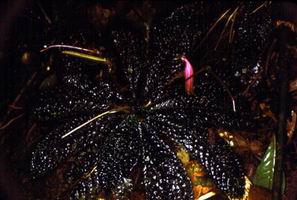 |
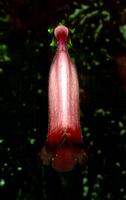
|
Ridleyandra atrocyanea (Ridl.) A.Weber (type species)
Penins. Malaysia, Perak, G. Bujang Melaka, phot. A. Weber (1987) |
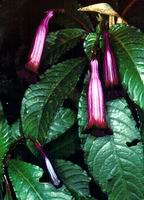 |
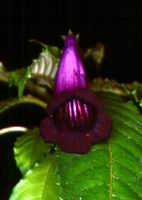 |
Ridleyandra porphyrantha (A.Weber &
R.Kiew) A.Weber
Penins. Malaysia, Selangor, G. Bunga Buah, phot. A. Weber (1987) |
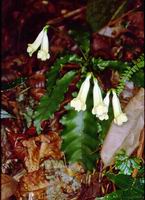 |
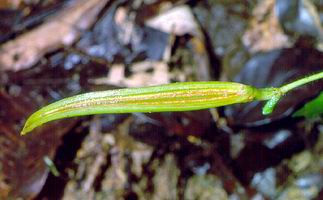 |
Ridleyandra quercifolia (Ridl.)
A.Weber
Penins. Malaysia, Perak, Maxwell's Hill, phot. A. Weber (1995) |
Ridleyandra sect. Stilpnothrix
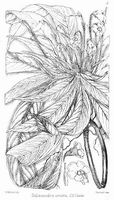 |
Ridleyandra ornata (C.B.Clarke)
B.L.Burtt
C.B. Clarke, in A. & C. DC, Monogr. phan. 5/1, t. 8 (1883) |
last modified: 2007-01-05